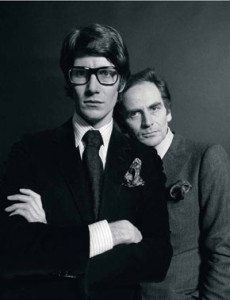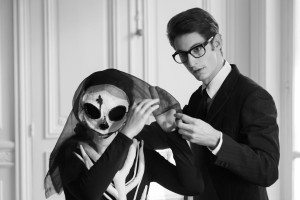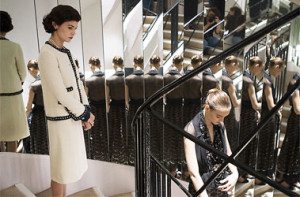Hollywood’s New Clothes: The Limitless Potential of Designer Biopics
Studios might develop a habit of jumping from trend to trend – teen dystopias, fairy tale remakes and superheroes being the current frontrunners – but some genres remain relevant for decades. Biopics, in particular, always have a special fascination for people because of their intrinsically real protagonists. The individuals in question might have led especially fascinating lives, but they tend to be more believable than your average blockbuster fair, if for no reason other than the fact that they did actually exist.
2014 has seen the release of two rival biopics based on the life of Yves Saint Laurent, the French fashion designer who redefined the industry by introducing the tuxedo suit for women and renowned for his collaborations with non-white models. Although both projects cover the same subject, their routes from script to red carpet were very different. In many ways, they provide an interesting study on how designer biopics approach their topic.
Yves Saint Laurent, already released in the UK, follows the eponymous designer’s early life and rapid rise to the peak of the haute couture scene. His long-time business partner and lover, Pierre Bergé, has been extremely supportive of the film. He not only allowed the production to film several key scenes at the YSL headquarters on Avenue Marceau in Paris, he also lent out 77 vintage outfits from their archives to be used in the project.
For a film about fashion design, clothes are basically the special effects, so to have exclusive access to Saint Laurent’s actual designs gave it an unmatchable authenticity. Having Bergé’s blessing certainly helped and, while the film has had its detractors, it remains largely faithful to what really happened. The same cannot be said for yet-to-be-released Saint Laurent. Charting the designer’s later life, with a focus on his drug use and casual sex, and his relationship with AIDS victim Jacques de Bascher, it has definitely managed to annoy many of the designer’s closest associates due to its supposed liberal use of artistic license.
As far as their focus on Yves Saint Laurent is concerned, the films seem to be looking at distinctly different stages of his life and could, in theory, be considered two halves of a whole story. They have obvious dissimilarities – one is effectively an authorised biography, the other a renegade venture that even had to build its wardrobe from scratch – but they tackle the same plot. More importantly, they reignite the possibility of creating more biopics based on designers.
Contrary to popular belief, fashion labels and their founders do not share a formulaic history, which would admittedly make films on multiple subjects redundant. In the same way that political biopics each have a different central plot, designer biopics have a wide range of stories to look at. The two films on Yves Saint Laurent, for instance, examine a prodigious talent that was simultaneously fuelled and tainted by homophobic experiences, drug abuse and mental illness.
Biopics about Coco Chanel, meanwhile, look at a designer who epitomised female liberation by defying the corseted silhouette of her predecessors. The 2008 version, starring Shirley MacLaine as an elderly Chanel, highlights her romantic encounters. The following year’s Audrey Tatou-starrer, Coco Avant Chanel (Coco Before Chanel) traces her life from an abandoned orphan to a French icon. And there are further aspects of her life to be adapted for the screen, including her infamous links with the German intelligence agencies during World War II.
Contrary to popular belief, fashion labels and their founders do not share a formulaic history, which would admittedly make films on multiple subjects redundant. In the same way that political biopics each have a different central plot, designer biopics have a wide range of stories to look at.
The docu-drama McQueen and I recaps the life and death of Britain’s most celebrated and tortured designer, Alexander McQueen. As someone who redefined notions of beauty, he remains a staple of contemporary fashion even after his heart-breaking suicide. While his death may be a tricky subject to film in a scripted feature, his life would make for a very compelling film, especially given his revolutionary take on high fashion clothing. Not to mention the fact that his iconic collaborations with the likes of Lady Gaga and Björk, as well as his design label’s work on Kate Middleton’s wedding dress, make him an indelible part of the modern cultural zeitgeist.
Furthermore, there are countless other designers whose lives have yet to be given any sort of cinematic treatment, but who would make brilliant subjects for biopics. There is Christian Dior and his riches to rags to riches story of hailing from a wealthy family and suffering from tragic personal loss during the Great Depression before achieving fame as a fashion giant. Or perhaps Madame Grès and her struggle of balancing artistic freedom with commercial viability. Diane von Fürstenberg and Elie Tahari would make for wonderful stories of the power of the American dream, while Domenico Dolce and Stefano Gabbana would provide an interesting spin on the whole “surprise friendship” shtick. And, if anyone wants to make a controversial project to get tongues wagging, just look at John Galliano and his infamous 2011 tirade.
Designers are not merely tailors and seamstresses; they are artists who celebrate soaring highs and suffer crippling lows. At its heart, cinema is an art form that experiences the same ebbs and flows. With criticisms of unoriginality and stagnation being levelled at the film industry, perhaps it is high time it takes a serious look at its spiritual sister as a new muse. If nothing else, the costumes would be a joy to look at.




Comments